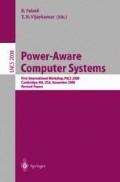Abstract
Because the inductive noise Ldi/dt is induced by the power change and can have disastrous impact on the timing and reliability of the system, high-performance CPU designs are more concerned with the step power reduction instead of the average power reduction. The step power is defined as the power difference between the previous and present clock cycles, and represents the Ldi=dt noise at the microarchitecture level. Two mechanisms at the microarchitecture level are proposed in this paper to reduce the step power of the floating point unit (FPU), as FPU is the potential “hot” spot of Ldi=dt noise. The two mechanisms, ramping up and ramping down FPU based on instruction fetch queue (IFQ) scanning and PC+N instruction prediction, can meet any specific step power constraint. We implement and evaluate the two mechanisms using a performance and power simulator based on the SimpleScalar toolset. Experiments using SPEC95 benchmarks show that our method reduces the performance loss by a factor of four when compared to a recent work.
Part of this research was performed while Mr. Tang was an intern with HP in the 2000 summer. Mr. Tang and Dr. He were partially supported by SRC grant 2000- HJ-782. This research also used computers donated by SUN Microsystems. Address comments to lhe@ece.wisc.edu and nchang@hpl.hp.com.
Access this chapter
Tax calculation will be finalised at checkout
Purchases are for personal use only
Preview
Unable to display preview. Download preview PDF.
References
Y.-S. Chang, S.K. Gupta, and M.A. Breuer, “Analysis of ground bounce in deep sub-micron circuits,” in VLSI Test Symposium, IEEE, IEEE Computer Society Press, pp. 110–116, 1997.
M. Pant, P. Pant, D. Wills, and V. Tiwari, “An architectural solution for the inductive noise problem due to clockgating,” in Proc. Int. Symp. on Low Power Electronics and Design, pp. 255–257, 1999.
S. Manne, A. Klauser, and D. Grunwald, “Pipeline gating: Speculation control for energy reduction,” in International Symposium on Computer Architecture, 1998.
A. Raghunathan, S. Dey, A. Horak, T. Mudge, and K. Roy, “Low-power system design: Application, architectures, and design methodologies,” in Proc. Design Automation Conf, 2000.
N. Vijaykrishnan, M. Kandemir, M.J. Irwin, and H.S. Kim, “Energy-driven integrated hardware-software optimization using simplepower,” in International Symposium on Computer Architecture, pp. 95–106, 2000.
E. Musoll, “Predicting the usefulness of a block result: a micro-architectural technique for high-performance low-power processors,” in 32nd Annual International Symposium on Microarchitecture, November 1999.
E. Macii, M. Pedram, and F. Somenzi, “High-level power modeling, estimation and optimization,” in Proc. Design Automation Conf, 1997.
Y. Li and J. Henkel, “A framework for estimating and minimization energy dissipation of embedded hw/sw systems,” in Proc. Design Automation Conf, 1998.
M. Pant, P. Pant, D. Wills, and V. Tiwari, “Inductive noise reduction at the architectural level,” in International Conference on VLSI Design, pp. 162–167, 2000.
D. Burger and T. Austin, The simplescalar tool set version 2.0. University of Wisconsin-Madison, 1997.
G. Z. Cai, K. Chow, T. Nakanishi, J. Hall, and M. Barany, “Multivariate power/performance analysis for high performance mobile microprocessor design,” in Power-Driven Microarchitecture Workshop In Conjunction With ISCA98, June 1998.
A. Dhodapkar, C. Lim, and G. Cai, “tem2p2est: A thermal enabled multi-model power/performance estimator,” in Workshop on Power Aware Computer Systems, Nov 2000.
Q. Wu, Q. Qiu, M. Pedram, and C. Ding, “Cycle-accurate macro-models for rt-level power analysis,” IEEE Trans. on Very Large Scale Integration (VLSI) Systems, vol. 6, pp. 520–528, December 1998.
H. Mehta, R. Owens, and M. Irwin, “Energy characterization based on clustering,” in Proc. Design Automation Conf, June June 1996.
F.N. Najm, “A survey of power estimation techniques in VLSI circuits,” IEEE Trans. on Very Large Scale Integration (VLSI) Systems, vol. 2, pp. 446–455, December 1994.
S. Gupta and F. N. Najm, “Power macromodeling for high level power estimation,” in Proc. Design Automation Conf, pp. 365–370, June 9-13 1997.
D. Liu and C. Svensson, “Power consumption estimation in CMOS VLSI chips,” IEEE Journal of Solid-state Circuits, pp. 663–670, June 1994.
J.L. Hennessy and D.A. Patterson, Computer Architecture: A Quantitative Approach. Morgan Kaufmann Publishers, 1996.
J. Fisher and S. Freudenberger, “Predicting conditional branch directions from previous runs of a program,” in Proc. Fifth Conf. on Architectural Support for Programming Languages and Operating Systems, IEEE/ACM, pp. 85–95, October 1992.
V. Tiwari, D. Singh, S. Rajgopal, and G. Mehta, “Reducing power in high-performance microprocessors,” in Proc. Design Automation Conf, pp. 732–737, 1998.
E. Macii, M. Poncino, and R. Zafalon, “RTL and gate-level power optimization of digital circuits,” in Proc. IEEE Int. Symp. on Circuits and Systems, 2000.
Author information
Authors and Affiliations
Editor information
Editors and Affiliations
Rights and permissions
Copyright information
© 2001 Springer-Verlag Berlin Heidelberg
About this paper
Cite this paper
Tang, Z., Chang, N., Lin, S., Xie, W., Nakagawa, S., He, L. (2001). Ramp Up/Down Functional Unit to Reduce Step Power. In: Falsafi, B., Vijaykumar, T.N. (eds) Power-Aware Computer Systems. PACS 2000. Lecture Notes in Computer Science, vol 2008. Springer, Berlin, Heidelberg. https://doi.org/10.1007/3-540-44572-2_2
Download citation
DOI: https://doi.org/10.1007/3-540-44572-2_2
Published:
Publisher Name: Springer, Berlin, Heidelberg
Print ISBN: 978-3-540-42329-4
Online ISBN: 978-3-540-44572-2
eBook Packages: Springer Book Archive

